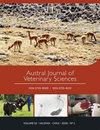小品种犬髌骨内侧脱位髌股参数的诊断价值:切向x线研究
IF 0.5
4区 农林科学
Q3 VETERINARY SCIENCES
引用次数: 0
摘要
了解髌股放射学参数的诊断价值对评估小品种犬内侧髌骨脱位(MPL)的状态具有重要意义。本研究对4个小型犬品种(迷你平切犬、波美拉尼亚犬、吉娃娃犬和约克夏犬)46个健康的膝关节和72个II级和III级MPL关节进行了回顾性调查。在切线x线片上测量以下形态计量学参数:滑车沟角、滑车外侧和内侧倾角、滑车深度、水平和垂直髌骨直径、外侧和内侧髌骨小面长度、外侧和内侧小面角、Wiberg角、一致性角和轴向髌骨线性位移。进行受试者工作特征(ROC)分析,评估与MPL相关参数的截止值、敏感性和特异性。滑车沟角度和滑车深度能够一致地识别mpl影响关节(auc >0.9)。描述髌骨在滑车沟内位置的参数(一致性角和髌骨轴向线性位移)最准确,AUC超过0.990,灵敏度/特异性超过94%。髌骨形态参数对区分健康和MPL患者无诊断价值。本文章由计算机程序翻译,如有差异,请以英文原文为准。
Diagnostic value of patellofemoral parameters in small breed dogs with medial patellar luxation: a tangential X-ray study
Knowing the diagnostic value of radiological patellofemoral parameters is important for evaluating the status of small-breed dogs with medial patellar luxation (MPL). This retrospective survey was conducted in four small dog breeds (Mini Pinscher, Pomeranian, Chihuahua, and Yorkshire terrier) on 46 healthy stifle joints and 72 joints with grade II and III MPL. The following morphometric parameters were measured on tangential radiographs: trochlear sulcus angle, lateral and medial trochlear inclination angles, trochlear depth, horizontal and vertical patellar diameters, length of the lateral and medial patellar facets, lateral and medial facet angles, Wiberg angle, congruence angle, and axial linear patellar displacement. Receiver operating characteristic (ROC) analysis was performed to evaluate the cut-off values, sensitivity, and specificity of the parameters associated with MPL. The trochlear sulcus angle and trochlear depth were capable of consistently identifying the MPL-affected joints (AUCs > 0.9). The parameters describing the position of the patella within the trochlear groove (congruence angle and axial linear patellar displacement) were found to be the most accurate, with an AUC of over 0.990 and a sensitivity/specificity of over 94%. The patellar morphology parameters had no diagnostic value in distinguishing between healthy and MPL stifles.
求助全文
通过发布文献求助,成功后即可免费获取论文全文。
去求助
来源期刊

Austral Journal of Veterinary Sciences
Veterinary-General Veterinary
CiteScore
1.60
自引率
0.00%
发文量
18
期刊介绍:
Austral Journal of Veterinary Sciences (formerly Archivos de Medicina Veterinaria) publishes original scientific contributions in English, containing the latest developments and discoveries in veterinary sciences. The journal covers topics such as animal health and production, preventive medicine, zoonosis, pharmacology and therapeutics, methods of diagnosis, and other areas related to the veterinary field.
Austral Journal of Veterinary Sciences aims to divulge information about advances in veterinary medicine among universities, research centres, industries, government agencies, biologists, agronomists and veterinarians.
 求助内容:
求助内容: 应助结果提醒方式:
应助结果提醒方式:


